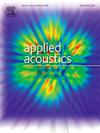基于最小二乘的参数阵列扬声器光栅瓣抑制优化方法
IF 3.4
2区 物理与天体物理
Q1 ACOUSTICS
引用次数: 0
摘要
参数阵列扬声器(PAL)是一种具有小孔径的高方向性声源。利用相控阵技术,pal可以在不机械旋转声源的情况下实现声束导向。然而,由于超声波波长通常小于换能器的尺寸,这违反了空间奈奎斯特准则,并导致在辐射方向图中形成不必要的光栅瓣,因此出现了一个挑战。为了解决这个问题,本文采用了一种复杂的加权方案,该方案结合了元件振幅和相移,有效地抑制了给定元件位置的光栅瓣,同时允许紧凑的配置。给出了PAL卷积模型的矩阵表达式,并提出了最小二乘(LS)优化方法来获得最优的复权值。仿真和实验结果表明,基于ls的优化方法有效地减轻了可转向PAL的光栅瓣,大大减少了计算时间,实现了转向所需元件权重的实时计算。与传统的模拟退火算法相比,该方法的计算效率提高了2300倍,实现了动态场景下的实时波束形成。此外,本文还分析了阵列单元数、载波频率和音频频率对PAL光栅瓣特性的影响。分析表明,存在难以抑制光栅瓣的波束转向盲点。本文章由计算机程序翻译,如有差异,请以英文原文为准。

A least squares based optimization method for grating lobes suppression in parametric array loudspeakers
The Parametric Array Loudspeaker (PAL) is a highly directional sound source with a small aperture. By using phased array technology, PALs can achieve sound beam steering without mechanically rotating the source. However, a challenge arises due to the ultrasonic wavelength being typically smaller than the size of the transducers, which violates the spatial Nyquist criterion and leads to the formation of unwanted grating lobes in the radiation pattern. To address this issue, this paper employs a complex weighting scheme that incorporates both element amplitude and phase shifts, effectively suppressing the grating lobes for given element positions while allowing for a compact configuration. The matrix formulation of the PAL convolution model is provided, and a least squares (LS) optimization method is proposed to obtain the optimal complex weights. Simulation and experimental results demonstrate that the LS-based optimization effectively mitigates the grating lobes of the steerable PAL, resulting in significantly reduced computation time, enabling real-time calculation of the required element weights for steering. Compared to conventional simulated annealing algorithms, the proposed method achieves a 2300-fold acceleration in computational efficiency, enabling real-time beamforming in dynamic scenarios. Additionally, the paper analyzes the impact of the number of array elements, carrier frequency, and audio frequency on PAL grating lobes behavior. The analysis reveals the existence of beam steering blind spots where grating lobe suppression is difficult to achieve.
求助全文
通过发布文献求助,成功后即可免费获取论文全文。
去求助
来源期刊

Applied Acoustics
物理-声学
CiteScore
7.40
自引率
11.80%
发文量
618
审稿时长
7.5 months
期刊介绍:
Since its launch in 1968, Applied Acoustics has been publishing high quality research papers providing state-of-the-art coverage of research findings for engineers and scientists involved in applications of acoustics in the widest sense.
Applied Acoustics looks not only at recent developments in the understanding of acoustics but also at ways of exploiting that understanding. The Journal aims to encourage the exchange of practical experience through publication and in so doing creates a fund of technological information that can be used for solving related problems. The presentation of information in graphical or tabular form is especially encouraged. If a report of a mathematical development is a necessary part of a paper it is important to ensure that it is there only as an integral part of a practical solution to a problem and is supported by data. Applied Acoustics encourages the exchange of practical experience in the following ways: • Complete Papers • Short Technical Notes • Review Articles; and thereby provides a wealth of technological information that can be used to solve related problems.
Manuscripts that address all fields of applications of acoustics ranging from medicine and NDT to the environment and buildings are welcome.
 求助内容:
求助内容: 应助结果提醒方式:
应助结果提醒方式:


